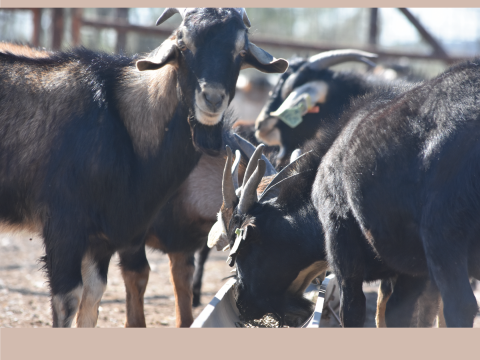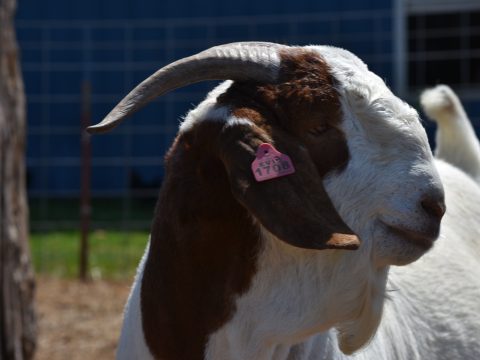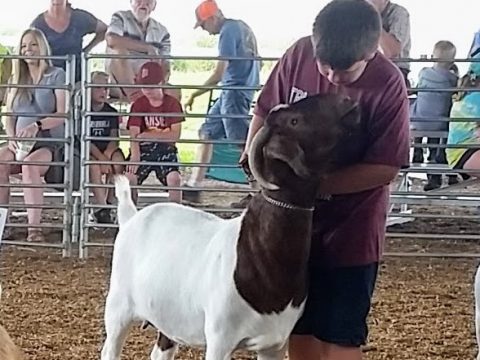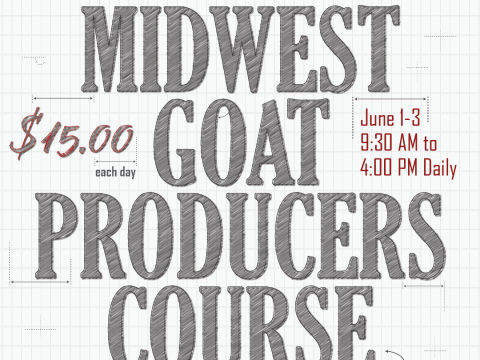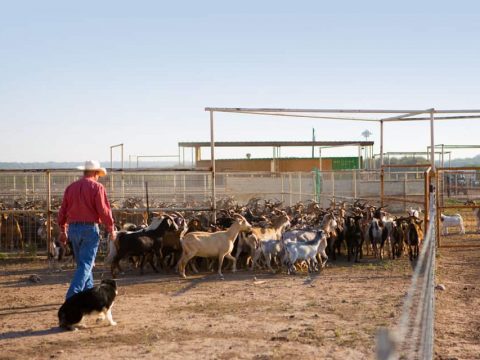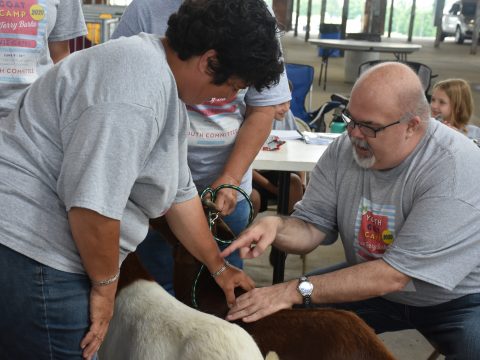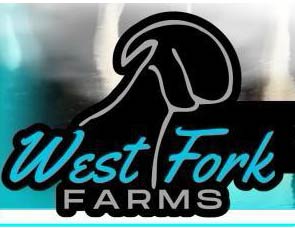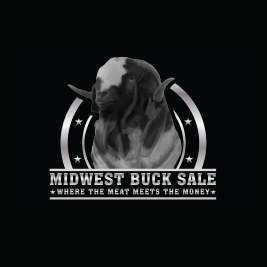
Dr. Frank Pinkerton Chapter 2 #2
8. Marketing Goats from Farm to Consumer
Introduction
In the first article, Basics of Meat Goat Marketing, in this Chapter, I used Figure 1 to illustrate the six ways that producers could market their slaughter goats. As promised, this article now describes the opportunities and constraints you would likely encounter if you chose to sell your goats directly from the farm, either live or ‘dressed whole’ or cut into wholesale or retail cuts or made into value-added products.
I am deeply indebted to fellow columnist, Ms. Sandra Miller, Sandra@pa.net or www.painted-handfarm.com, for permitting—indeed, encouraging—me to borrow at will from her series of Rancher articles, mostly on direct marketing of goats and goat meat, beginning in Aug ’08 and not yet ended at press time for this book. I prefer to think she is a really nice person willing to share expertise freely rather than thinking I desperately need guidance to avoid grievous educational error. I am also indebted to Dr. Jeanne Dietz-Band (manyrocksfarm@myactv.net) for review and helpful clarifications to this article. Like Sandra, she also practices direct marketing of goat meat.
Ways to sell live goats directly from the farm
The simplest way to ‘direct-market’ a goat is to sell it to a customer who comes to your farm, makes a selection, pays the asking price, puts the chosen-one in car or truck, and departs. In this scenario, you and the customer both benefit in that you avoid hauling costs, commission, and shrinkage and he/she gets a healthy, farm-fresh goat of known provenance. A slightly modified version of this sales gambit can occur if you agree to haul the goat for a fee (either overt or covert) to a nearby locker plant, or other facility, for slaughter at the direction of the new owner and at his cost.
In a related strategy, a producer agrees to sell a goat to a customer, takes the money, and then allows the new owner to slaughter the goat on the farm. This may or may not be legal, depending on the particular statutes of a given State. If it is legal and if both parties agree to the disposition of the offal, then there will be no problems. Contrarily, if it is not legal, then the owner/seller is subject to legal action, not the buyer. Accordingly, the risk involved makes this an iffy alternative and disproportionately so for the owner/seller. Do not suppose that you can long ‘get away with’ this activity; your neighbors or enemies or competitors are likely to ‘out’ you sooner than later. Remember, too, that while you can legally slaughter your goat for your own use, you cannot slaughter your goat and sell the carcass to a customer.
Still another version of direct sales occurs when an owner takes one or more goats to an off-farm site for selling. One here thinks of farmer’s markets or ‘flea markets’ or of roadside sales conveniently near an urban/exurban area. In all cases, once the bartering is concluded and the money exchanged, the seller bears no further responsibility. This is a Good Thing because the transport and subsequent slaughter of the goat (whenever, wherever, however) is thus legally shifted to the new owner; blissful ignorance of any consequences is the preferred seller stance.
Other ways to sell goat meat directly from the farm
If you should elect to explore options beyond live goat sales, for example, slaughtering goats on-farm and selling carcasses or cuts or value-added products via an on-farm ‘sales room’, you must first learn about the Health Code Requirements of the State Agency in charge of these two matters. A preliminary call to your State Department of Health/Food Safety and Inspection Office will do much to further, or pause, or possibly even stifle your game plan for on-farm slaughtering, processing and merchandizing. It is most assuredly not a time for unilateral action, no matter your views on bureaucratic ‘meddling’ and such. Doing otherwise will court legal and financial disaster. Various licenses are usually required to market meat products directly to consumer, restaurants, and grocery stores. A state license is typically an annual requirement to sell meat products, particularly at farmer’s market venues.
If you do decide to pursue these options further, a host of additional issues must be considered, among them: identifying/maintaining reliable customers; obtaining sufficient supplies (raised and/or purchased) of goats to meet demand patterns for your products; planning for inventory management, cash-flow, price discovery, etc; and, not least, finding enough hours and energy to perform the myriad tasks sure to be encountered. To produce, slaughter, process, and merchandize your own goats is an incredibly complex and daunting task. Even if you realize (get all) the profits to be made from each of these separate activities, there is the matter of achieving sufficient sales volumes to sustain the enterprise, not to mention sustaining your physical health and mental equilibrium and that of your Loved Ones.
Over the years, I have observed numerous instances of integrated enterprises (goat milk production, homestead cheese making, and merchandizing activities) compromise health and erode net worth—and also observed compromise marriages, straight or gay—in CA and elsewhere. There is a salutary message in this history for overly exuberant, imperfectly informed meat goat persons. The required 24/7 schedule in such integrated operations can be ignored for a while (as can the debilitating labor and equally exhausting mental concentration), but, sooner than later, there will come a time when willingness, enthusiasm and sharing responsibilities will not—cannot—replace mutually satisfying togetherness, either intimate or mundane.
As a consequence, the accumulating stresses lead first to heavy silences, then covert and overt pouting, then mutual shouting, then deadly low-voiced dissention, and, finally, tears and recrimination regarding possible disposal of well-loved goats. Even a cooling interlude of trial separation may not avoid d-i-v-o-r-c-e. As always in such instances, bankers hover and lawyers loom, as also unwelcome I-told-you-so comments from ‘concerned’ friends and family. In these circumstances, to bail, or not to bail, is not the question; only the times of dissolution and departure will be in play.
But… as always, there are the exceptions that prove the rule. There are indeed those who raise goats (usually having them slaughtered off-farm) and then fabricate, process, and personally sell the output. The volumes involved tend to be small, but the markups tend to be relatively high. In these instances, personality, perseverance, and smarts are absolutely required attributes, as also are tolerance of long and arduous hours. On occasion, a comforting glass or two of ethanol in some form—red, white, or brown—has been found useful for sustainability. One also imagines that hired hands would logically be preferable to Significant Others, firings being preferable to messy disengagements.
One solution to the incipient 24/7 nightmare described above would be to undertake only one or two of these three major, post-production activities. For example, you could elect to have your goats custom-slaughtered and also processed into products or, alternatively, process the carcasses in your own pre-approved processing facility/kitchen. In either case, you could then elect to do your own merchandizing or, alternatively, sell to a wholesaler for subsequent retailing.
You could of course decide not to raise goats at all, but rather to buy them and thereafter proceed as described above. In that case, you might elect procurement, custom-slaughter, and then doing your own processing and merchandizing, in which case life would still be full to the max and boredom a past indulgence. However, Dr. Jeanne D-B cautions that many farmers markets, restaurants, and natural-food stores that are looking for fresh, local produce demand that you (the seller) also be the producer of the animal. Accordingly, procuring goats elsewhere for your meat products might well limit your marketing opportunities.
Not so curiously, these post-production alternatives closely reflect the marketing functions delineated in Figure 1, Marketing Channels, cited above. You must in fact decide which one, or more, of these channel functions you want to undertake. Each function requires a player, and each player strives to make a profitable return to labor, management, and investment. Thus, your gut question becomes: can you do one, or more, of these functions more cheaply than the current players do them? If not, you cannot survive your decision to become a player.
On occasion, I make a similar case to prospective cooperative endeavors by groups of producers dissatisfied with auction prices for their kid crops; their bottom line is the same as yours as an individual. Accordingly, any Co-operative must, like you, do one or more marketing functions more cheaply, or… they/you must create a novel product to distribute/sell at a (sustainably) higher price than other players. After 30 years in the goat world, I still know of no other ways to achieve the laudable goal of vertical integration in a splintered industry, either individually or co-operatively.
Assessing alternatives for slaughtering, processing, and merchandizing goats
Determine first the availability, acceptability, and limitations of one or more ‘local’ custom-slaughter facilities. An existing facility can almost certainly slaughter goats more cheaply than you can (think here of their output volume). But, if the facility is beyond economical hauling distance for delivery and pickup, you necessarily consider constructing/equipping an on-farm slaughter facility.
In any case, when discussing possibilities for custom slaughter, cost/head is, of course, the major concern, but certainly not the only one. Is the facility federally approved, or only state-approved? Can you get a recurring date/time for slaughtering your goats? Do you have to bring some minimum number each time? Can the goats be killed according to Halal and/or Kosher standards? Can you ‘get’ only whole carcasses? Halves? Quarters? Primal cuts? Ground meat? Sausage products? How will the meat be prepared for transport? A crucial corollary question is, what sort of refrigerated truck or ‘ice box’ must you have to transport carcasses or pieces for sale or further processing? Dr. Jeanne is again helpful, suggesting that you contact http/www.fsis.usda.gov/regulations_&_policies/state_inspection_programs/index.asp. This link can answer the crucial question as to which states require only USDA inspection and which will also accept state inspections; other useful information is also included.
Many small slaughter plants do only hanging carcasses, not further-processing. Such a situation forces one to then choose between doing carcass fabrication and/or further–processing activities in your approved on-farm facility or, alternatively, hauling carcasses to a commercial processor whose charge would include a margin of profit which you would ‘lose’.
The merchandizing function (activity) remains the same whether you do the processing or have it custom-processed. To merchandize goat meat products, they have to be properly labeled. This process can be a bit tedious and aggravating, but it is a legal necessity. All labels must be pre-approved by the Federal or State Agency inspecting the meat processing and packaging facilities. There are specific requirements as to what must appear on the label and also for the terminology to be used. Beyond the labeling issues, there are crucial decisions as to types and sizes of cuts and proper packaging; seek counsel and proceed cautiously. Refer to the Meat Goat Guide in the Chapter on Meats or contact Dr. Ken McMillin, LSU meat scientist, for more detail.
In any case, during these deliberations on further processing of hanging carcasses, it is good to again review certain facts about goat carcass yields. Live kid goats, hauled short distances and held overnight on water only, will shrink about 3% of their farm weight. The hot carcass yield (dressing percentage) will range 47-52 depending on grade, body condition, and pre-slaughter shrinkage. Carcasses typically shrink an additional 3% or so during overnight chilling (and another 1-2 % if left hanging for some days). We have found a further loss of 2-4% as chilled carcasses are fabricated into primal cuts. For those considering deboning a carcass for patties, sausages, stix, or jerky, the yield of boneless meat will be about 60% of the chilled carcass weight.
To sum, a 70 lb goat at the farm would yield about 21 lb (33%) of usable boneless meat. If you could sell this goat at the auction for, say, $90, the basic cost of his boneless yield would be $4.28/lb (90/21) to which you would have to add the cost of slaughter and boning, say, $50 total or $2.38/lb of boneless meat (50-/21). Thus the cost of the 21 lb of meat/lb is $6.66 (4.28 + 2.38). Thereafter, one must add the cost of ‘sausage’ making/packaging and distribution cost bringing the total cost/lb to, say, $10.00. If you sold the product for $14/lb, the profit for post-auction activities would be $4.00/lb or $84/goat (4x 21). Such a sum would probably be about twice what you could have netted from a live sale at auction.
Merchandizing goat carcasses, fabricated cuts and processed products
In commercial meat goat marketing channels, carcasses and ‘bone-in cubes’ move from packers to wholesalers, retailers, restaurants and other institutional trade. Currently, few primal cuts (legs, back strips, shoulders) or retail cuts (roasts, steaks, patties, or processed products) are on offer. Ethnic groups are by far the largest consumers and, to date, they have not demonstrated significant demand for goat meat in non-traditional form (or perhaps it just hasn’t been widely offered?).
Contrarily, there seems to be increasing evidence that certain ethnic groups are now considering primal cuts, retail cuts, and processed products as families with two or more wage earners recognize the sheer convenience of smaller cuts and ground goat meat, as also the lesser dollar outlay/purchase. But, tradition is, as all know, difficult to breech, and particularly so in food choices.
I’m so old I can remember that homogenized milk (said to be unnatural and dangerous to one’s health) took several years to be accepted, as did margarine to ‘replace’ butter, while fresh meats are preferred to frozen items to this very day (even though consumers can’t distinguish between them as to palatability traits, nor is nutritional value lost). The current public angst regarding irradiated meat and milk is also similarly and scientifically unfounded, but also similarly feared (possible alteration of DNA codes, infertility, sterility, and, worse, impotence). Neither Europeans nor deployed U.S. military personnel seem to have been adversely impacted; such inconvenient facts are, of course, regularly ignored in the interest of preserving one’s ideology, as defined.
In any case, the newest consumers of goat meat are not from such tradition-bound ethnic groups. As so aptly described by Ms. Miller in the September ’09 issue of Goat Rancher, the newest, most enthusiastic eaters of goat meat are increasingly found in that segment of the population that is choosing to ‘make a social statement through the use of their food dollars’. This population demographic is itself increasing rapidly and is projected to do so for ‘some time’. Its’ primary concerns encompass a number of public issues, among them ‘eating local, sustainability, healthfulness, and food safety’. Given the documented reproductive efficiencies of Latinos, Greeks, Italians, and Muslims from assorted geopolitical jurisdictions, goat meat consumption, irradiated or not, may be considered quite beneficial—healthful, too.
Though I have seen no confirming research, I suspect that average incomes and available food-dollars are appreciably higher for this new demographic than for the more traditional consumers of goat meat. If true, this would so Be a Good Thing because goat producers pursuing direct-marketing strategies and tactics, as described above, simply must sell their products at substantial premiums in order to recoup their investment, operational costs, and adequate recompense for their time, labor, and knowledge.
Accordingly, customers for these ‘special products’ must be persuaded that the convenience, quality, consistency and safety of the proffered products are worthy of the premiums required to sustain their supply. Such persuasion, whether based on social morality/utility, nutritional physiology, palatability, or convenience, is an integral part of any vertically integrated production, processing, and merchandizing scheme you may devise. If you and your products cannot command such allegiance, loyalty and premium prices, you will be reduced, finally, to selling your slaughter goats on the ‘commodity market’; do not believe otherwise.
Concluding, and most pertinent, observations by Dr. Jeanne Dietz-Band, to wit: first, be prepared to tell your customer about your farm, your management practices, and the humane standards you have set for your farm. A goodly number of customers will seek this information. Also be prepared to accommodate those customers that ask to visit your farm to see how the goats are raised (FP: treated). Your openness about your practices and your willingness to let people come to the farm will go a long way in winning over this new, educated group of consumers (FP: these activities would also help further your goals of repeat-customers and word-of-mouth advertising).
Secondly, engage in ‘selling yourself’ conversations. Many people that have never tried goat meat will make a decision to purchase based upon your own enthusiasm for the products you offer. Be prepared to share recipes and cooking tips because many people have never cooked goat meat before. If you do not routinely cook, eat, and enjoy your own product, it will be hard to convince new buyers to try what you have on offer. (FP: these prospective customers will most likely not be from traditional ethnic groups with a history of goat meat cookery/consumption so they can be usefully assisted in their novel culinary explorations. A bad experience, early on, may take them out of the notion, forever).


